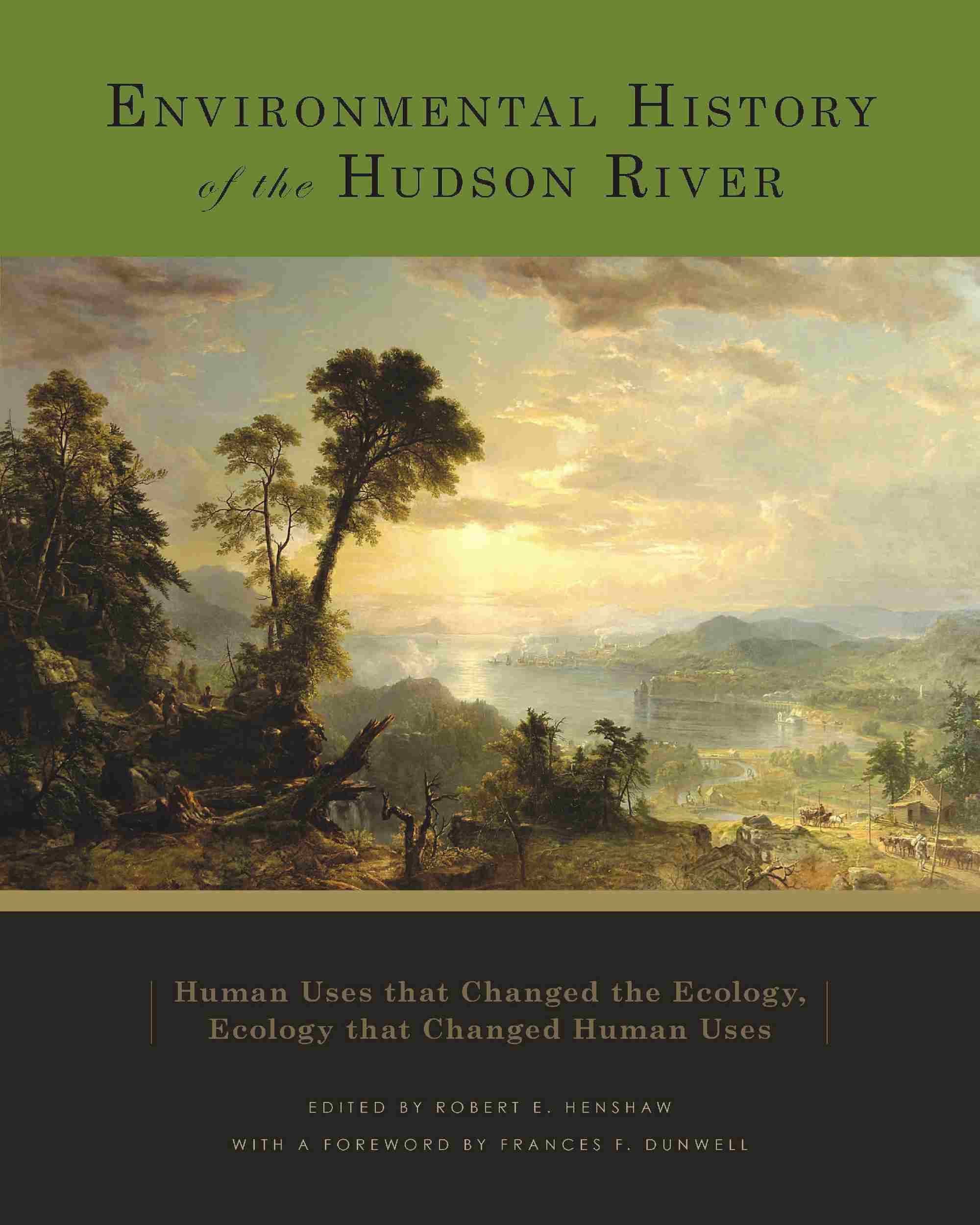Environmental History of the Hudson
Human Uses That Changed the Ecology; That Changed Human Uses

$76.50 - hardbound or $28.50 - paperback
Send check and mailing address to: Hudson River Environmental Society, PO Box 279, Marlboro, New York 12542
Available from SUNY University Press or from your local bookstore
The history of the Hudson River, America's most beautiful and important river, is like no other. The Hudson River was settled strictly for commerce, unlike the English colonies of New England and Virginia that were settled for ideological reasons. And this persisted for the four hundred years since, by a secular people with uncommon energy driven mostly by an ideology of succeeding at their trade. The all season port at the southern terminus was key, moving furs, forest and agricultural products from upriver, and sugar and slaves from the Caribbean. Commerce gained momentum due especially to trade in cotton from the southern states, resulting in New York City becoming the World Trade Center. Despite the pervasive driving force of commerce however, the river retained its world class scenic quality. The Upper Hudson River remains today a free flowing tumbling mountain stream; the Lower Hudson a fjord penetrating, and dominated by, the Hudson Highlands.
During the Hudson’s recent 400 years, its heterogeneous secular, and often rambunctious, population inspired America’s first literary school. The scenic grandeur inspired them to create America’s first school of art, the Hudson River School of landscape painting. A century later Hudson River residents still were inspired by the Hudson River School of Art when they challenged environmentally damaging, and poorly regulated, power development. The favorable court decisions they won led directly to the birth of America’s, and thus the World’s, Environ-mental Movement. This book, then, describes 400 years of uses, abuses, neglect and resurrection of the Queen of America’s rivers, the Hudson.
The central theme of this book is how human uses always affect the ecology, sometimes so pervasively that it forecloses continuing those uses, told by respected scientists and scholars with the passion and interest of participants, but with the objectivity of formal scholarly endeavor demands. Some review the effects on particular resources including shorelines, water quality, forests, and fisheries. Others discuss key impacting industries including agriculture, ice harvesting, chemicals, power generation, and the rise to the World Trade Center. Several authors explain the reasons for the Hudson River inspiring the first American literary school, the first American art school, and the environmental movement. These seemingly disparate subjects are woven into one unfolding environmental history in the section introductions. Together they seek to demonstrate the reciprocal relationship of how human uses impact the ecology, and how the ecology changes human uses. We gain a greater appreciation for our own actions and recognize that we are all a part of the Hudson’s unique history as it goes on today. Surely the Hudson River will continue to play an outsized role shaping the future in remarkable ways. We invite the reader to be an active, and informed, part of it.
CONTENTS
Foreword Frances F. Dunwell
Hudson River Estuary Program, NYS DEC
An Abbreviated Geography of the Hudson River Basin
Part I Biology And History: Providing Explanations
Chapter 1. Historical Facts / Biological Questions Robert Henshaw
Chapter 2. Linkages between People and Ecosystems: How Did We Get From Separate to Equal? Stuart E. G. Findlay
Chapter 3. Symbioses between Biologists and Social Scientists Lucille L. Johnson
Part II river of resources
Chapter 4. Hudson River Fisheries: Vast To Dwindling in 400 Years Robert A. Daniels, Robert E. Schmidt, and Karen E. Limburg
Chapter 5. Herpetofauna of the Hudson River Watershed: a Short History Alvin R. Breisch
Chapter 6. Human Impacts on Hudson River Morphology and Sediments – A Result of Changing Uses and Interests Frank O. Nitsche, Angela Slagle, William B.F. Ryan, Suzanne Carbotte, Robin Bell, Timothy Kenna and Roger Flood
Chapter 7. The Earliest Thirteen Millennia of Cultural Adaptation Along the Hudson River Estuary Christopher R. Lindner
Chapter 8. Archaeological Indices of Environmental Change and Colonial Ethnobotany in 17th Century Dutch New Amsterdam Joel W. Grossman
Chapter 9. Linking Uplands to the Hudson River: Lake to Marsh Records of Climate Change and Human Impact Over Millennia Dorothy Peteet, E. Margraf, D. Pederson and S. Sritrairat
Chapter 10. Vegetation Dynamics in the Northern Shawangunk Mountains: The Last 300 Years. John E. Thompson and Paul C. Huth Chapter
Chapter 11. Agriculture in the Hudson Basin Since 1609 Simon Litten
Chapter 12. Ecology in the Field of Time: Two Centuries of Interaction Between Agriculture and Native Species in Columbia County, NY Conrad R. Vispo and Claudia Knab-Vispo
Chapter 13: The Introduction and Naturalization of Exotic Ornamental Plants in New York’s Hudson Valley Chelsea L. Teale
Part III River of Commerce
Chapter 14. The Rise and Demise of the Hudson River Ice Harvesting Industry: Urban Needs and Rural Responses Wendy E. Harris and Arnold Pickman
Chapter 15. Human Sanitary Wastes and Waste Treatment in New York City David Tonjes, C. O’Connell, O. Aphale, Lawrence Swanson
Chapter 16. Foundry Cove: Icon of the Interaction of Industry with Aquatic Life Jeffrey S. Levinton
Chapter 17. River City: Transporting Commerce and Culture Roger Panetta
Chapter 18. Out Of The Fray: Scientific Legacy of Environmental Regulation of Electric Generating Stations in the Hudson River Valley John R. Young and William P. Dey
Part IV River of Inspiration
Chapter 19 Birth of the Environmental Movement in the Hudson River Valley Albert K. Butzel
Chapter 20. The Influence of the Hudson River School of Art in the Preservation of the River, Its Natural and Cultural Landscape, and the Evolution of Environmental Law Harvey K. Flad
Chapter 21. “Thy Fate And Mine Are Not Repose”: The Hudson And Its Influence Geoffrey L. Brackett
Chapter 22. The Past as a Guide to a Successful Future Robert E. Henshaw
Afterword Robert E. Henshaw
